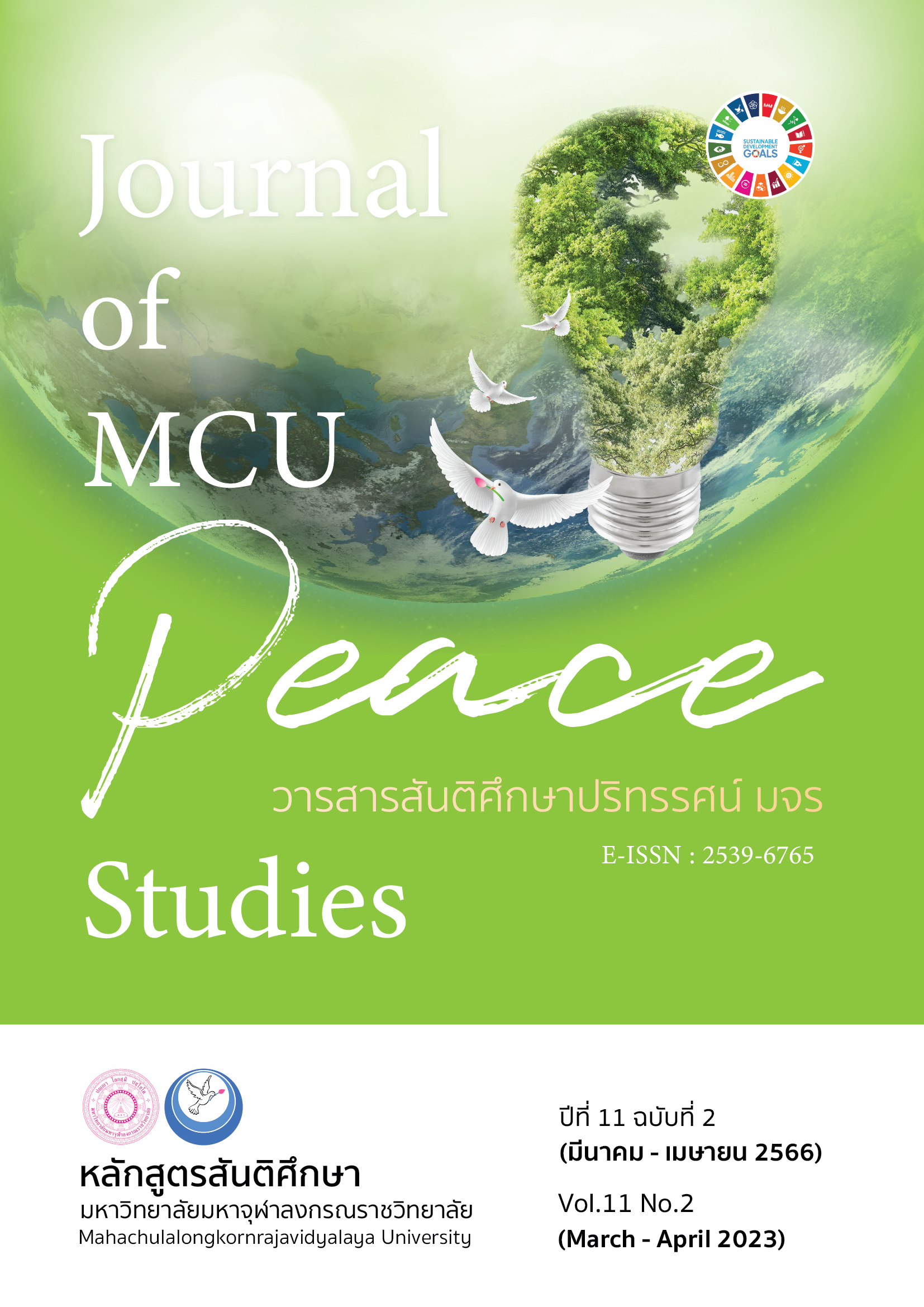อำนาจและปัจจัยที่ส่งผลต่อการดำรงอยู่ของผู้หญิงล้านนา ในพื้นที่สื่อพิธีกรรมบูชาบรรพบุรุษ (ผีปู่ย่า)
Main Article Content
บทคัดย่อ
บทความวิจัยนี้มีวัตถุประสงค์เพื่อ 1) ศึกษาอำนาจของผู้หญิงล้านนาในสื่อพิธีกรรมบูชาบรรพบุรุษ (ผีปู่ย่า) และ 2) วิเคราะห์ปัจจัยที่ส่งเสริมและเป็นอุปสรรคต่ออำนาจของผู้หญิงล้านนา จากอดีตสู่ปัจจุบัน แบ่งออกเป็น 3 ยุค คือ ยุคผู้หญิงเป็นใหญ่ (ก่อนปี พ.ศ. 1984) ยุคผู้หญิงเปลี่ยนแปลงสถานะและตัวตนแบบใหม่ (พ.ศ. 1984-2539) และยุคผู้หญิงเข้าไปในพื้นที่สนามประลองและแข่งขัน (พ.ศ. 2540-2564) โดยใช้การวิจัยเชิงคุณภาพ เก็บข้อมูลจากเอกสารบันทึก การสังเกตการณ์ภาคสนาม การสัมภาษณ์เจาะลึก และนำข้อมูลมาวิเคราะห์เชิงพัฒนาการทางประวัติศาสตร์
ผลการวิจัยพบว่า 1) ยุคผู้หญิงเป็นใหญ่ การใช้อำนาจผ่านการสวมรอยอำนาจสิ่งศักดิ์สิทธิ์ มีเป้าหมายเพื่อจัดการทรัพยากรและพิธีกรรมของเครือญาติ ยุคผู้หญิงเปลี่ยนแปลงสถานะและตัวตนแบบใหม่ การใช้อำนาจผ่านการแปลงร่างใหม่ มีเป้าหมายเพื่อการหารายได้จุนเจือครอบครัว ยุคผู้หญิงเข้าไปในพื้นที่สนามประลองและแข่งขัน การใช้อำนาจผ่านการแตกตัวตนและความรู้แบบผู้หญิง มีเป้าหมายเพื่อตัวเอง วงศ์ตระกูล และชุมชนสังคม ซึ่งอำนาจในแต่ละยุคอยู่ภายใต้ความเชื่อการบูชาบรรพบุรุษ (ผีปู่ย่า) 2) ปัจจัยที่ส่งเสริม คือ ปัจจัยภายใน ได้แก่ ระบบครอบครัวแบบสังคมล้านนา การแบ่งพื้นที่อำนาจทางวัฒนธรรมหญิงชาย การหล่อหลอมความเชื่อล้านนา และสถานภาพของตัวสื่อพิธีกรรม ปัจจัยจากตัวผู้หญิงล้านนา ได้แก่ การอยู่ติดพื้นที่ การสร้างพื้นที่เป็นเพศศักดิ์สิทธิ์ การโยกความรู้และพื้นที่การสื่อสาร ส่วนปัจจัยที่เป็นอุปสรรคคือ ปัจจัยภายใน ได้แก่ ระบบครอบครัวเดี่ยว ปัจจัยภายนอก ได้แก่ เศรษฐกิจแบบเงินตรา อิทธิพลของพุทธศาสนา นโยบายจากภาครัฐส่วนกลาง การเข้ามาของเพศที่สามในพื้นที่พิธีกรรม กระแสโลกาภิวัตน์ และสังคมแห่งความเสี่ยง
Article Details

อนุญาตภายใต้เงื่อนไข Creative Commons Attribution-NonCommercial-NoDerivatives 4.0 International License.
ทัศนะและความคิดเห็นที่ปรากฏในบทความในวารสาร ถือเป็นความรับผิดชอบของผู้เขียนบทความนั้น และไม่ถือเป็นทัศนะและความรับผิดชอบของกองบรรณาธิการ ยินยอมว่าบทความเป็นลิขสิทธิ์ของวารสาร
เอกสารอ้างอิง
Aksrondit, T. (2009). Spiritual Dance Rituals: Reflections on Social Bargaining Power Phenomenon. Chiang Mai: Tarnpanya Company.
Bourdieu, P. (1977). Outline of a Theory of Practice. Cambridge: Cambridge University Press.
Chaisompan, S. (2002). Women’s Roles in the Transmission of Beliefs and Rituals in Northern Communities. (Master’s Thesis). Graduate School: Chiang Mai University. Chiang Mai.
Duongdeetaweerat, A. (2005). The Strengthening and Developing the Role of Local Media for Community Development. Bangkok: The Thailand Research Fund (TRF).
Foucault, M. (1980). Power Knowledge: Selected Interviews and Other Writings. New York: Pantheon Books.
Ganjanapan, A. (2012). Guardian and Ancestral Spirits: The Dynamics of Folk Knowledge the Power and Identity of the Local People. Chiang Mai: Chiang Mai University.
Ganjanapan, A. (2017). Lanna History: Movement of Life and Culture Local. Chiang Mai: Chiang Mai University.
Kaewthep, K. (2010). New Perspective Communication Education. Bangkok: Parbpim Printing.
Kaewthep, K. (2017). Tools for Community Culture and Media Education Rituals. Bangkok: Princess Maha Chakri Sirindhorn Anthropology Centre Printing.
Kaewthep, K., & Hinviman, S. (2008). The Stream of Thinkers Political Economy and Communication Education. Bangkok: Graphic Arts Limited Partnership.
Phanichphant, V. (2005). Cutural Way of Lanna. Chiang Mai: Silkworm Books.
Ramitanondh, S. (2002). Worship Warrier Spirits. Bangkok: Kledthai.
Santasombat, Y. (1993). Women and Their Families and Changes in Northern Thai Peasant Society. Journal of Sukhothai Thammathirat, 6(2), 23-37.
Singhanetra-Renard, A. (2009). Ancestral Spirit Cults (Phi Pu Nya) and The Position of Women in Changing Northern Thai Society. Journal of Humanities and Social Sciences, 3(2), 42-76.
Thammathi, S. (2011). Spiritual in the Belief of Lanna. Chiang Mai: Rom Phayom Printing.
Tisdung, K. (2016). Borderland and Diversity of Belief Systems: Contested Sacred Space and Symbolic Domination. Bangkok: The Thailand Research Fund (TRF).
Williams, R. (1981). Culture. London: Fontana.
Wongthet, P. (2006). Gender in Southeast Asia. Bangkok: Ruenkaew Printing.


